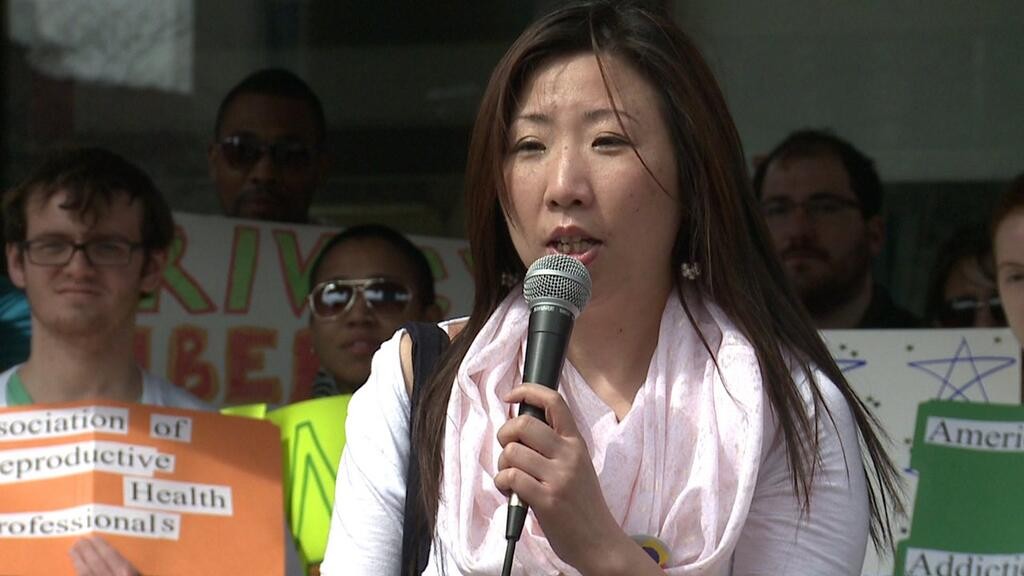
Last month, Purvi Patel faced two seemingly contradictory charges filed against her by the state of Indiana: feticide (actions leading to the death of a fetus in utero) and child neglect (actions that injure or cause death to a child resulting from a live birth). After a lengthy trial, the 33-year-old Indian American woman was found guilty on both counts in the death of her late-term fetus.
The State contends that Patel took black market drugs obtained from Hong Kong to induce a late-term abortion. This argument is based on text messages between Patel and a friend in which Patel considers buying those illegal abortion-inducing drugs. Yet, there is no evidence that Patel actually purchased any such drugs, and no traces of drugs were found in either Patel or her fetus.
Patel’s defense says the criminal charges were punitively filed over a death resulting from a traumatizing miscarriage.

Patel’s fetus was allegedly conceived with a married co-worker. Afraid of her parents’ strict prohibition on premarital sex and hoping to protect the identity of the fetus’ father, Patel hid the pregnancy. In Indiana, most abortions are not covered by health insurance or public funding, it is required that all women seeking an abortion receive “counseling” designed to discourage it, and 93% of counties lack any abortion clinic.
Advocates for Patel say that after deciding against an abortion, Patel wasn’t feeling well on July 13, 2013 and suffered a miscarriage in her bathroom.
“[I]t just all fell out, is how she describes it … gushing blood on the floor,” [Sue Ellen] Braunlin [of Indiana Religious Coalition for Reproductive Justice] says.
Patel says she attempted to resuscitate the fetus with mouth-to-mouth, and then eventually realized that she was bleeding out and needed to go the hospital. Patel wrapped the fetus in paper towels and garbage bags and disposed of it in a dumpster, and went to the hospital where she initially refused to admit that she had been pregnant.
Patel’s doctors — who are mandatory reporters when they suspect a case of possible abuse — notified authorities who found the discarded fetus. Patel was immediately charged with feticide, even while law enforcement subjected her to a battery of questions, including interrogating her as to the race of the fetus’ father. Reports PRI:
When [Patel] woke up at 3 a.m. [after surgery], an officer was there to interrogate her. Emma Selm of the Indiana Religious Coalition for Reproductive Justice later watched a recording of the hospital interrogation that was shown at Patel’s trial, this past January.
“[The officer] asked about, ‘So who’s the father of this baby?’” Selm says. “[Patel] acted kind of embarrassed, like she didn’t want to talk about it. And he said, ‘Was it a one night stand or something? Oh, and was he Indian too?’ He kept going on about ‘was he Indian and where is he?’”
Patel’s conviction is controversial in no small part because the prosecution’s case hinged upon a long since debunked test to determine if the fetus was born alive or not. Coroners used the “lung float test” (or hydrostatic test), a test that almost pre-dates the invention of the modern scientific microscope for examination of biological tissues and which is about as scientifically rigorous as throwing women into lakes to see if they float as method of determining if they are witches. Slate reports:
“It’s an absolutely discredited test,” said Gregory Davis, a professor of pathology and laboratory medicine at the University of Kentucky. “It boggles my mind that in the 21stcentury … this test is still being relied upon to determine whether a baby is born alive or dead.”
Davis is not the only forensic pathologist who believes the float test is unreliable. The most recent edition of Knight’s Forensic Pathology, a widely used textbook, says “there are too many recorded instances when control tests have shown that stillborn lungs may float and the lungs from undoubtedly live-born infants have sunk, to allow it to be used in testimony in a criminal trial.” The authors of another textbook,Essentials of Forensic Medicine, called the test “pointless” in 1984.
Davis, who is also the assistant state medical examiner for the commonwealth of Kentucky, said there are at least three reasons why a float test could yield inaccurate results, indicating the presence of air in the lungs even though the fetus never took a breath. The first is easiest to understand: If any attempt at resuscitation was made, either through mouth-to-mouth or chest compressions, that can introduce air into a lung, thus causing it to float even if the fetus was stillborn. The second has to do with decomposition: If the fetus has decomposed even a little bit, the lungs can fill with gas bubbles that would also result in the lung floating. Finally, Davis said, a fetus’s lungs can fill with air just by going through the vaginal canal, because pressure on the chest creates a “bellows effect.”
Nonetheless, the results of the State’s “lung float test” combined with Patel’s text messages were enough for a jury to make Purvi Patel the first woman in Indiana found guilty under the state’s new feticide laws; such laws are common to 38 states in the United States.
Patel is the first convicted, but not the first woman tried under Indiana’s feticide laws, which reproductive justice advocates say were originally designed to add a layer of legal protection for pregnant women from abusive domestic partners whose violence results in the death of a fetus.
In 2012, 34-year-old Chinese American immigrant Bei Bei Shuai was tried in Indiana for feticide after an unsuccessful suicide attempt wherein she drank rat poison, and which resulted in the death of her fetus. Reports the Guardian:
On 23 December 2010 Shuai became so depressed after she had been abandoned by her boyfriend – a married Chinese man who broke his promise to set up a family with her – that she decided to end her life. She consumed rat poison, and after confessing to friends was rushed to the Methodist hospital.
Doctors took steps to save her, but on 31 December there were signs that the baby, then at 33 weeks gestation, was in distress and a Caesarian was performed. On the second day of Angel’s life the baby was found to have a massive brain haemorrhage and on 2 January was taken off life support.
Shuai held Angel for five hours as the baby gradually faded and died. “Why do they want to take my baby away?” she kept asking, in between bouts of fainting. Shuai begged for her own life to be taken so that her child’s might be spared.
Indiana’s reproductive justice advocates were reportedly “astonished” by the prosecution’s decision to pursue this case, particularly in a state where suicide (or attempted suicide) is not illegal. Faced with a likely murder trial, Shuai ultimately accepted a plea deal to a lesser charge.

In 2011, Rennie Gibbs was charged with murder under Mississippi’s similar feticide laws for the death of her fetus in 2006, when she was 15 years old. Gibbs, who is Black, lost her fetus at 36 weeks. When law enforcement discovered that Gibbs was addicted to cocaine during the time of her miscarriage, they charged her under the state’s new feticide laws, even though experts later disputed the initial finding that the fetus had died of cocaine toxcity, arguing instead that death likely resulted from the umbilical cord being wrapped around the fetus’ neck. Charges were dropped against Gibbs in 2014 — who was the first woman in Mississippi to face feticide charges — although prosecutors are free to refile.
In other words, feticide laws in Indiana and Mississippi that were originally designed to protect pregnant mothers are now being used to criminalize them; and, alarmingly, these laws are also being used disproportionately to target immigrant women and women of colour who lack the political and economic resources to fight back.
This shouldn’t necessarily come as a surprise: anti-abortion activists and legislators are increasingly adopting a racialized tint to their anti-choice activism. Stereotypes of the bad Black mother are deeply ingrained in the Right’s War on Women. Meanwhile, the National Asian Pacific American Women’s Forum has been tracking a specific breed of anti-abortion legislation — sex-selective abortion bans — for the last years, and says that 21 states have considered adopting such laws. In states where these laws have been proposed, racist and xenophobic stereotyping that depicts Asian immigrants as misogynists and unfit mothers have been openly used as a significant contributing rationale.
Indiana is currently considering passage of their own sex-selective abortion bans.
These cases reveal the anti-abortion movement’s new tactic of ending abortion by criminalizing pregnant women, and specifically through the targeting of women from vulnerable communities. In Alabama, the state has filed charges against more than 40 women after the state passed a “chemical endangerment” law in 2006 (and upheld by the state’s Supreme Court in 2014) which allows the state to prosecute pregnant women for using a controlled substance during their pregnancy. Critics warn that this sets a dangerous precedent for the state to decide prenatal care. Meanwhile, Alabama’s rates of substance abuse deaths appear to be on the rise compared to 1999, and the state ranks poorly in its state-wide strategies for providing resources to help addicts overcome their addictions.
These laws do little to protect women, or even unborn fetuses; instead, they set the precedent that women — and particularly, women of colour — should be prosecuted for their prenatal choices, even when we have ample evidence to believe that those choices were the result of a system that has long ago failed these women. The use of feticide laws to prosecute — rather than protect — pregnant women is a corruption of the spirit of these laws, and only pushes these already underserved pregnant women further underground and outside of the reach of available support and resources. How can we claim to have moral interests at heart when we establish this kind of racist and punitive system of criminalizing mothers, or elevating the “personhood” of a fetus over that of its mother?
All of Purvi Patel’s actions indicate that she was motivated by fear of disclosing her pregnancy — whether to her parents or to the larger community. How in the world does convicting her for feticide after a miscarriage address this problem at all? How does this make the next pregnant woman of colour in Indiana more likely to step out of the shadows and seek help?
Answer: it doesn’t.
